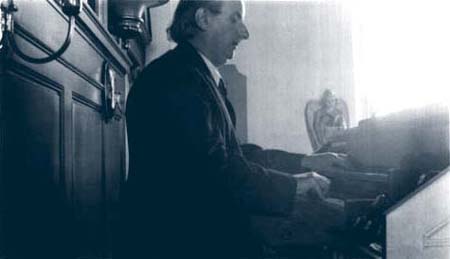a Biographical Multimedia Mosaic...
Messis (Høstens Tid) (Messis - Time of Harvest)
Messis (Høstens Tid) (Messis - Harvest Time), with its total playing time of two hours, is one of the major works in the history of organ music.
In its outward framework, the work concentrates on the life and thoughts of Jesus. At the same time, however, it is a massive reflection on the period around the turn of the century, which Langgaard, using a biblical phrase, called "The Harvest Time". The harvest time - in Latin, "messis" - symbolises the end of the world, and in Langgaard's opinion the period around the turn of the century not only marked the culmination of the history of music so far, but carried a mystical aura of decadence, the dissolution of values and imminent decline. This strange ambiguity is reflected in the composite nature of the music, as Langgaard drew on the full expressive register of the Romantic and Late Romantic periods.

Rued Langgaard performs the second part of Messis for his Swedish friends in the little church at Brunnby on
Kullen, September 1936.
In 1936 Langgaard performed the first part, which also bears the title Messis, and the second part Juan at two concerts in Copenhagen Cathedral. He had not performed solo organ concerts in Copenhagen for 24 years, and the press made a big thing out of it in advance. The critics, however, were merciless, and as a result he was not allowed to perform the last part, Begravet i Helvede (Buried in Hell), in the cathedral.
Listen to two small excerpts from the central movement of the first part, bearing the title Høstens Tid (Time of Harvest), in which two kinds of music confront each other.